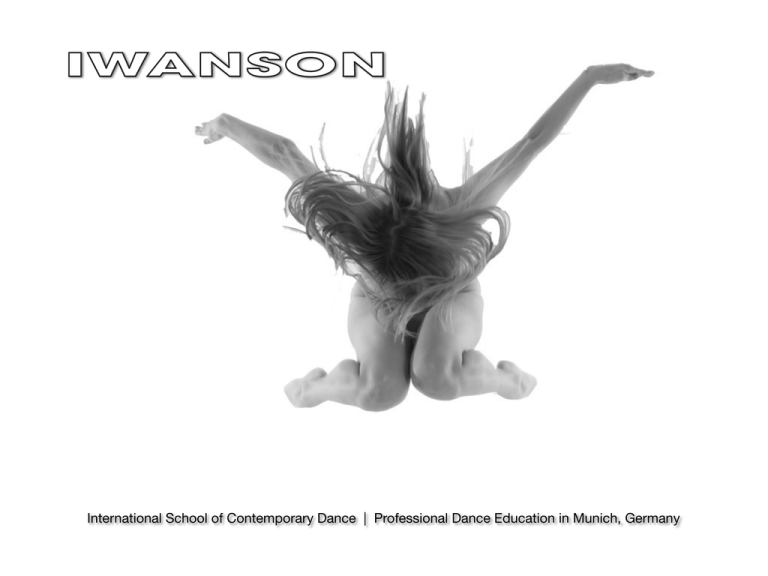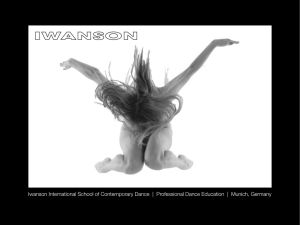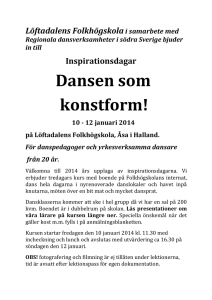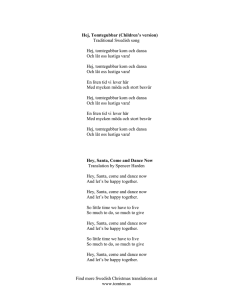International School of Contemporary Dance
advertisement

International School of Contemporary Dance | Professional Dance Education in Munich, Germany
Iwanson International
PROFESSONAL DANCE EDUCATION
TANZAUSBILDUNG | BÜHNENREIFE
YRKESUTBILDNING
FORMAZIONE PROFESSIONALE
EDUCACIÓN DE DANZA
PROFESIONAL
DANSEUDDANNELSE
PROFESYONEL DANS EGITIMI
לימודי מחול
танцовальное образование
!"#$('& ا
ダンス職業訓練教育
Iwanson International School of Contemporary Dance in Munich is
one of the internationally most recognized academies in Europe.
The three-year program focuses on different styles of contemporary
dance, ballet, jazzdance/hip-hop, choreography, partnering, floor
work, yoga as well as anatomy and dance history to give the student
in-depth knowledge about today's art of dance.
Starting from the second year already, contemporary classes are held
by internationally well-known teachers and choreographers.
To develop stage experience and choreographic skills, students
perform their own choreographies as well as with the repertory or new
work of established choreographers.
Iwanson International i München räknas idag till en av de ledande
skolorna för yrkesutbildning av moderna dansare och danspedagoger.
Många av våra utexaminerade elever har utmärkts med priser och
stipendier.
Under utbildningen har du dagliga klasser i klassisk balett, modernt
(flera olika stlilar) och jazzdans. Därutöver har vi klasser i partnering,
floor-work, drama, yoga, improvisation, koreografi, repetitioner med
internationellt kända koreografer likaväl som teoretiska ämnen som
danshistoria, anatomi och pedagogik.
För att utveckla scennärvaro och koreografisk interesse visar
studenterna regelbundet egna arbeten och dansar i välkända
koreografers verk.
Curtains up !
Jessica Iwanson: "The Soul of a School are its Teachers"
If we think about our schooldays, it is not the rooms or the events we
remember most but the teachers, the bad ones and the good ones.
I myself remember till today some practical corrections, hints and tips
I received in class. We are formed for life by our teachers.
That’s why I am not satisfied with our teachers just being good
pedagogues. They must also be artistic personalities who can be role
models and guides beyond the daily lessons. I am concerned that each
teacher of a particular subject always keeps the big idea in mind, that as
a team, all of them support each other and the students. We have found
a good way to ensure this team spirit: many of our full time teachers are
former Iwanson students and thus transport almost by definition a
common identity. But of course, we don’t just keep to ourselves: Our
Munich guest teachers bring much welcomed impacts from the
surrounding artistic circles. The Munich guests work as dancers, ballet
masters or choreographers, they come from the independent dance
scene or from the Munich State Theatre at Gärtnerplatz or the National
Theatre Munich.
And last but not least, the international influence is also very palpable: At
Iwanson we have introduced a system of rotating teacher employments
for the higher classes. Every one or two weeks a different, internationally
known artist gives guest lessons. The students get in touch with the
latest international trends in contemporary dance, they learn to quickly
adapt to different personalities, techniques and artistic genres. Thus the
students broaden their view – and also their network.
This constant change of teachers is a very fragile construct, and a very
demanding balance between inner identity and outer inspiration, between
technique and creativity. But a soul is also a very fragile construct.
The Iwanson Program
1st Year
We work on basics. Lessons in ballet and contemporary dance forms with a very strong focus on clean
dance technique are the every day base of the three coming years. But even jazz and hip-hop classes are
part of the timetable. New for most is the work on the floor: today it is a very necessary skill to be able to
sweep across the floor easily, not showing the effort behind. Special coaching lessons broaden the
technique in ballet and contemporary dance. Once a week the students study history of dance and
anatomy. Foreign students get German tuition. At the end of the week, one may be exhausted, but there is a
goal: the 1st exam takes place before Christmas, and the 2nd one before summer.
2nd Year
A quite radical change happens: every week new international guest teachers bring the numerous
diverse styles of contemporary dance and modern partner work to the students. Now the only constant
is change: different teachers, different methods, different signatures. New subjects – improvisation and
choreography – demand openness and artistic sensitivity. The results are shown to the public in
“choreographic labs” in the nearby theatre. In February, the students face their 3rd exam. First grants are
awarded, either for exchange projects with academies in Stockholm and Göteborg, or for international
workshops. Finally, summer brings the 4th exam.
3rd Year
The focus is put on stage appearance. International guest choreographers rehearse with the students
for their final performance. Rehearsals are an important part in a dancer’s life. This exciting process
brings more variation than the daily routines but demands patience and personal initiative.
In the final phase we send students to their first auditions and castings, state theatres all over
Germany invite students to present themselves in “work experience weeks” and choreographers drop
by looking for dancers. The school opens up.
Each student prepares a solo as a piece for the exams, but also as a showpiece for future auditions.
On the last day of three exciting and challenging years, the soli are shown on stage and the diplomas
are handed over.
More than just a School - the Iwanson System
More than sweat and mirrors – the Iwanson System is an intricate network whose complex efficiency is sustained by many different factors.
Here are a few:
The Formula 1 strategy
Every detail is important. Nothing is left to chance. The wish to succeed is the motivation for innovation and improvement. This consequent and professional
strategy is basis for the dance training at Iwanson International.
Students become teachers
Many of today´s Iwanson teachers have been trained at the Iwanson, some even took their first dance steps here. For instance, Patrick Delcroix who was a
student in the early 80s has become a permanent dancer and choreographer with the Nederlands Dance Theater and happily returns once a year to teach in
his old school.
The Job Center
Iwanson Students are consistently prepared for their practical work on stage during their training. The school cooperates with many state theatres, from
Wuppertal in the west to Chemnitz in the east, from Lüneburg in the north to St Gallen in the south to facilitate work experiences. They provide the students
with their first contacts and often also with their first contracts as guest or permanent company members.
Survival training
Young artists change engagements often and need to present themselves again and again. This is why the schedule includes such untypical subjects like
presenting an acted out monologue and a dance solo, composing an artistic CV, doing their tax or deciding which insurances are necessary.Once a year, a
photographer visits the school. Each graduate obtains a series of professional shots which are essential for the coming applications. And of course, the
students can save their photos and CV on the school´s server and years later, still access it.
Competitions
In sports, competitions are part of the game. In music and classical ballet they are normal, but for contemporary dance they are still rather new. But there are a
few big competitions for modern dancers, especially “Stuttgart Rotebühlplatz” and the “Seoul International Dance Competition”. Iwanson recommends
students for these competitions who want to compare their performance on an international level – and the success rate speaks for itself: every year, Iwanson
graduates are among the finalists in both competitions.
Lobbying
That´s part of our commitment too! On the other side of the mirror, the case of contemporary dance is furthered in expert committees, in round table talks, on
conferences and within lobby groups. This is an important subject for executive director Stefan Sixt, who campaigns for youth and education as chairman of
the Bavarian Association for Contemporary Dance. He also writes about dance and cultural and political questions regularly in the journal “dance for you”.
Stefan Sixt: "Between Tradition and Innovation"
Journalists often ask "what is so special about Iwanson?" The
answer is: an instinct for the future of dance and the innovative
power to realize visions. Leaving behind what seems to become old
fashioned soon and at the same time not trusting the current taste.
Here are a few examples:
As early as 1990 we stopped teaching traditional modern dance
with Graham-, Cunningham- and Limón-technique. Instead we
focused on contemporary dance.
Some time later we introduced the guest teacher system. Every
week, the students meet internationally known choreographers to
be confronted with the diversity of contemporary dance on the
highest possible level.
In 2000 when to many people within the danceworld hip-hop
seemed to be just a commercial event, we put it on the curriculum.
Today hip-hop is acknowledged as a serious contemporary dance
form.
A couple of years ago we developed a new form of the students'
final performance. A series of very short choreographed pieces
gives every student the possibility to present him- or herself in a
wide range of styles. This attracts numerous choreographers and
directors who watch the performances in order to spot new talent.
And of course, there are still visions to be realized within the next
decade. This exciting artform transcends the boundaries of
language and allows free communication between all people.
Let me quote Chris Dercan, director of the London Tate Modern:
"Contemporary Dance is the most innovative artform of the 21.
century."
Iwanson International
At the reception desk of the school, the
visitor is greeted by a bable of
languages: Danish, Swedish, German,
English, Italian, a bit of Turkish, Hebrew
and Japanese…
This reflects the fact that less than half
of Iwanson’s 160 students come from
Germany.
Many come from the neighbouring
countries Austria, Switzerland, Italy,
England, France, Scandinavia and
Eastern Europe.
But also from Turkey, Israel or even the
USA, Australia, Korea, Chile, Mexico,
Mongolia or Japan dance students
make their way to Munich.
There must be a reason.
International Auditions
Iwanson International's students, usually have a good technical background in classical ballet,
contemporary and/or jazzdance. But even if you haven't come so far you can audtion for our
base-line 2.
To make audition more comfortable for our forreign students, you can present yourself not only
in Munich but in Stockholm, Copenhagen, London, Rome and Warzawa.
Sign up online from our website www.iwanson.de - all information is available in english,
swedish and italian language. You speak another language? Send an email, we will answer.
Teachers
Andreas Abele - independent contemporary choreographer in Munich
Alessandro Souza Pereira - dancer at the New Danish Dance Theatre
Friedrich Bührer -Musical Dancer in Berlin
Rosanna Brocanelli - Director of Opus Ballet Dance Company in Florence
Marielle Aranda - hip-hop and jazzdance teacher and choreographer
Regine Blum - jazzdance teacher and choreographer for musical dance
Trudie Campbell - ballet teacher and former dancer at the Munich Operahouse
Jarek Cemerek - contemporary dance teacher and choreographer from Prague
Patrick Delcroix - choreographer and dancer at Netherlands Dance Theatre
Camilla Ekelöf - Artistic Director of Regionalteater Väst inSweden
Stefanie Erb - contemporary dancer and choreographer and yoga teacher
Katharina Felsch - dancer and physiotherapist
Caroline Finn - contemporary dance teacher and choreographer
Nina Forgber - jazzdance teacher and performer
Pia Fossdal - contemporary dance teacher and choreographer
Romain Guion - contemporary dance teacher and choreographer
Johannes Härtl- contemporary dance teacher and choreographer
Jasmin Hauck - hip-hop choreographer and dancer at St. Gallen State Theatre
Jochen Heckmann - choreographer and artist in residence at Kempten State Theatre
Minka Marie Heiß - contemporary dance teacher and choreographer
Anke Helmann - dance scientist
Stephan Herwig -contemporary dance teacher and choreographer
Nina Hümpel - dance scientist and publisher
Jessica Iwanson - choreographer and director of the school
Jan Kodet - choreographer and choreographic assistent at Prague Opera
Isabella Kraus - musical dancer and dance teacher
Hannes Langolf - dancer at DV8 and Akram Khan, guest choreographer at Iwanson
Michael Langeneckert -contemporary dance teacher and choreographer
Beatrice Mari - ballet teacher and former dancer at the Munich State Theatre
Peter Mika - contemporary dance teacher and choreographer
Volker Michl - contemporary dancer, teacher and choreographer
Agnés Noltenius - contemporary dance teacher, former dancer at Forsythe Company
Charlotta Öfverholm - choreographer with own company in Stockholm
Hanna O'Dwyer - ballet teacher from Stockholm
Magdalena Padrosa - ballet teacher and rehearsal director at Munich State Opera
Andrew Resurreccion - hip-hop choreographer at Zurich Sonja Rodriguez - contemporary dance teacher and choreographer, Barcelona
Bawren Tavazia - contemporary dance teacher and choreographer from Zimbabwe/London
Lena Vieweg - jazzdance teacher and choreographer for youth groups
Katja Wachter - independent choreographer with own company in Munich Gabi Würf - choreographer and teacher for contemporary dance with children
Xiaoqiang Yan - contemporary dancer from Dance Theatre of China
Curtains up for: Young Dance!
The Iwanson initiative „Young Dance“ develops for contemporary dance what has already become the norm in sports and music:
a systematic, comprehensive, efficient and professional training carefully accompanying young students on their way to the top.
Since contemporary dance is itself still relatively young it hasn´t been able to develop those structures yet. Its leading dancers and
choreographers are still busy concentrating on their own artistic work. And the public funding of contemporary dance is usually reserved
for the more established colleagues.
This is where Iwanson’s concept of “Young Dance” comes in. High performance training for children, nation-wide youth training camps,
integration of other youth groups, and above all, time and a space for professional dance students who work on dance projects and stage
them for a wider audience. To keep to the sporting analogy, Iwanson carefully helps the students on their way from the first steps into the
first league.
Yet another idea from sports inspires imitation: competition. Through their respective clubs and leagues, children and young athletes meet
and compete regularly. Public appearance becomes routine, the next match is always on the mind.
Through “Young Dance” Iwanson creates a constant overlap of training, rehearsal and performance. There are studio presentations and
try-outs of “choreographic labs” as well performances of the works of internationally known choreographers in Munich state theatres.
Last season Iwanson produced about 50 student-performances in different dimensions. Stage appearance becomes a second nature for
a new generation of contemporary dancers and choreographers who have been given time and care to develop their artistic self.
As Iwanson is providing its students with many possibilities to perform, the audience for them has also grown. In 2011/12, more than
10.000 people saw Iwanson students on stage.
This new audience for contemporary dance is expecting a lot of these young dancers who combine freshness with skill and patience with
passion. Iwanson is proud of its students and sends them out into the professional world with confidence and trust.
The Iwanson-Sixt-Foundation
In 2007, Jessica Iwanson and her partner Stefan Sixt created the Iwanson-Sixt-Foundation, the first German foundation to foster young talent in
contemporary dance. The foundation encourages, supports and funds young contemporary dancers and choreographers on their artistic path. Travel
grants are distributed to help young dancers to present themselves at dancers´ and choreographers´ competitions or to participate in high quality
workshops. There are whole sponsorships for individual dancers and once a year the Isadora Awards are presented for special merits in the field of
contemporary dance.
Subsidized by the city of Munich, in 2008 the foundation rented a rehearsal-studio to provide students and young choreographers with special work
space. There they develop their pieces in a very creative atmosphere. International guest choreographers incorporate their repertoire and young,
independent companies have a place to rehearse.
Renowned choreographers such as the ballet director of the Munich State Theatre, Hans Henning Paar, or the Artistic Director of the Biennale in
Venice, Ismael Ivo are members of the advisory board and support the foundation’s work.
Isadora­Awardee 2012: Barbara Kaufmann
scholarship holder 2012: Christina Zaraklani, Linette Christensen, Kira von Kayser, Amalie Obitz, Marie Lyckemark, Josefine Stenström, Louisa Lövenhill,
Jenny Schinkler, Natalie Farkas, Beatrice Eriksson, Emma Bellerby, Mathilda Lissdaniels, Linn Eriksson, Mikael Orozco, Stefanie Olbort, Oriana Berger,
Helena Wilhelmsson, Sarah Kiesecker
scholarship holder 2011: Katharina Fürst, Rebecca Pettersson, Kathrin Plankensteiner, Lisa Reiss, Helen Aschauer, Helena Wilhelmsson, Mikael Orozco,
Giulia Rossi, Tanja Tamminen, Edith Buttingsrud, Therese Thonfors, Valentina Piperato, Rebecca Björling, Natalie Farkas, Stine Rønne, Anika Weiland,
Amanda Gustafsson, Sarah Kramer, Linn Lundmark, Elina Davidsson
Isadora­Awardee 2010: Andreas Abele, Ivonne Kalter, Harald Weiss
scholarship holder 2010: Piril Akar, Rebekka Björling, Helga Friedrich­Salgado, Evgenia Itkina, Minka­Marie Heiß, Heidi Huber, Valerie Leinweber,
Laura Much, Sandra Mühlbauer, Irmina Palczyinska, Puk Raundahl, Isabel Schwardt, Eva Simmeth, Inka Strobl, Lena Vieweg
Isadora­Awardee 2009: Johannes Härtl, Katja Wachter, Gabriele Würf
scholarship holder 2009: Ljuba Avvakumova, Karin Björneloo, Teresa Geßner, Susanne Hörmann, Ivonne Kalter, Beatrix Koller, Susi Mayer, Sandra
Mühlbauer, Laura Much, Carima Neusser, Lotte Probst, Susanna Schwarz, Michael Tang, Daniele Varallo
Isadora­Awardee 2008: Regine Blum, Minka­Marie Heiß, Sabine Prokop
scholarship holder 2008: Helene Brøndsted, Josefine Häggblad, Yumiko Higuchi, Christina Oedl, Marie Preußler, Sabine Prokop, Makoto Sakurai,
Mathias Schwarz, Laurie Stettner, Valerie Weyer
Isadora­Awardee 2007: Stefanie Erb, Pia Fossdal, Lil Rösch
scholarship holder 2007: Patrick Ablinger, Jasmin Hauck, Johannes Härtl, Anne Römeth, Lena Vieweg, Tanja Villinger, Malin Wallmark, Christine
Weidner, Cecilia Wretemark, Paola Zadra
Sveriges största dansutbildning utanför Sverige
Iwanson International School of Contemporary Dance i München räknas idag till en
av de ledande skolorna för yrkesutbildning av moderna dansare och
danspedagoger. Skolan har ett nära samarbete med staden Münchens
kulturnämnd och med de stora stadsteatrarna Gasteig och Gärtnerplatz.
Av de över 150 eleverna kommer en tredjedel från Sverige och Danmark. Många
av de utexaminerade elever har utmärkts med priser i internationella tävlingar och
har fått stipendier.
Utbildningen präglas av dagliga klasser i klassisk balett, modernt (flera olika stilar)
och jazzdans. Därutöver finns klasser i partnering, hip-hop, floor-work, drama,
yoga, improvisation, koreografi, repetitioner med internationellt kända koreografer
likaväl som teoretiska ämnen som danshistoria, anatomi och pedagogik. Framför
allt fokuserar skolan dock på scenvana. Redan från första läsåret medverkar
eleverna i en rad föreställningar på skolans egna studioscen och uppträdanden på
de stora stadsteatrarna.
I München kallas Jessica Iwanson pionjär och hennes namn är synonymt med
nutida dans. Hon har tilldelats den hedrande medaljen „München leuchtet“ som
avser ett livsverk och oftast delas ut till män i näringslivet. ‚Die Iwansonʻ, som hon
respektfullt kallas i sin hemstad, skapar sedan tre decennier kontinuerligt
koreografier för sitt eget kompani. Jessica Iwanson har själv studerat för legender
som Martha Graham, Alvin Ailey, Birgit Cullberg och Kathrin Dunham. Hon har
gästkoreograferat för bland annat Cramérbaletten, Norrdans, Malmö Stadsteater,
Östgötateatern, MBT i Århus, Hurjaruuth i Helsingfors. Hon var konstnärlig ledare
för dansproduktionen Café Pingvin på Riksteatern och chef för Carte Blanche,
Norges nationella kompani för nutida dans. 1997 skapade hon produktionen
„Nattfåglar“ för SVT som än i dag visas i repriser på kulturkanalerna arte och 3sat.
2007 grundade Jessica Iwanson och hennes partner Stefan Sixt en stiftelse för att
även i framtiden kunna gestalta dansens utveckling genom stöd för utexaminerade
dansare och koreografer. Stiftelsens styrelse stödjer det kulturpolitiska arbetet
genom ett europeiskt, konstnärligt nätverk och egna insatser som koreograf och/
eller teaterchef.
Till styrelsen räknas bl.a. Ismael Ivo, konstnärlig ledare av dansbiennalen i Venedig
och Hans Henning Paar, balettchef för 'Stadttheater Münsterʻ.
www.iwanson.de
Katja Wachter, Choreographin und Dozentin


